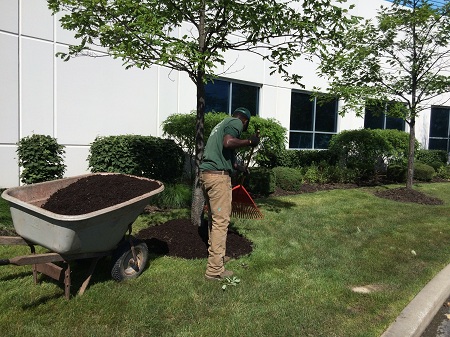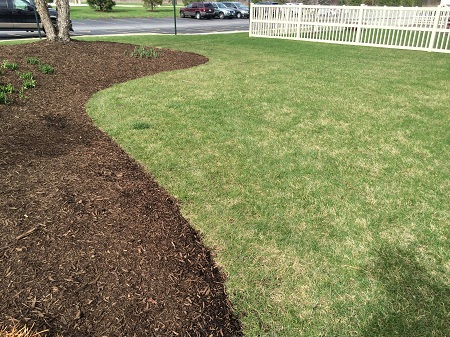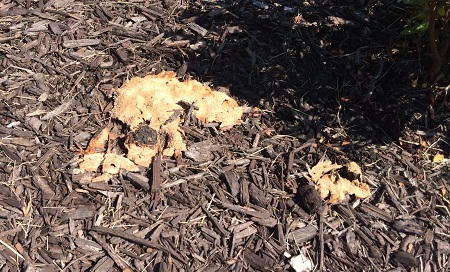Installing Mulch
Mulching of the planting beds is a very important item from a horticultural aspect that is often overlooked. Mulching the beds offers many health benefits to the existing landscape, as well as improve the aesthetics of your property.
Benefits Of Mulch
- Mulch breaks down with time into nutrients that the plants need, flowing into the soil and feeding the plants through their root systems. Think of mulch as a 3” layer of solid plant food.
- Prevents loss of water from the soil by evaporation.
- Reduces the growth of weeds, when applied deeply enough to prevent weed germination or to smother existing weeds.
- Keeps the soil cooler in the summer and warmer in the winter, thus maintaining a more even soil temperature and promoting better root development resulting in improved growth and blooms.
- Prevents soil splashing, which not only stops erosion but keeps soil-borne diseases from splashing up onto the plants.
- Mulches can improve the soil structure. As the mulch decays, the material becomes topsoil. Decaying mulch also adds nutrients to the soil.
- Prevents crusting of the soil surface, thus improving the absorption and movement of water into the soil.
- Prevents the trunks of trees and shrubs from damage by lawn equipment.
- Helps prevent soil compaction.
- Plants have more roots than plants that are not mulched, because mulched plants will produce additional roots in the mulch that surrounds them.
- Mulch also allows for weeds to be pulled while their roots are growing in the mulch, instead of roots growing into the soil where they could break off and re-grow again.
Even if your beds have don’t have plants, mulch will still benefit you by breaking down into nutrient form and enriching your existing soil. A test in the town of Crete, Illinois showed that in one year, 3” of hardwood mulch turned 1” of clay soil into usable, nutrient rich soil.
There is one draw back to hardwood mulch. It needs to be top-dressed every couple of years, depending upon how much mulch is installed. Our general recommendation is to install and maintain a level of approximately 3”-4” of mulch at all times, which should give you enough coverage for two seasons. However, for budget purposes, we can install 2” of mulch in all beds which would provide a good start, but might not last as long.
Colored Mulches
Most colored mulches are a man-made invention, dying the natural mulch to a black, red, or other color. Some mulches such as cypress mulch are naturally lighter and offer a different appearance. Although attractive when first installed, colored mulches can loose their color over time by fading in the sun or being exposed to large amounts of water. Top dressing of colored mulches can often be required more frequently than natural mulches.
When To Mulch
Any time is a good time to mulch your beds, even though there are different benefits at different times of year, mulching is a wonderful assistance to plants and soil all year round.
Winter mulching is primarily used as insulation for woody plants, laid down in late fall to keep the soil evenly cool throughout the winter. Winter mulching still provides all of the benefits of mulch listed above.
Spring/Summer mulching is normally after the soil begins to warm in the spring. The primary roles of summer mulches are to warm the soil, reduce weed growth, and retain soil moisture. Spring/Summer mulching still provides all of the benefits of mulch listed above.
How Deep to Mulch
Proper installation of mulch is more important than most clients realize. The amount of mulch to apply depends on the texture and density of the mulch material. Many wood and bark mulches are composed of fine particles and should not be more than 3 - 4 inches deep. Excessive amounts of these fine-textured mulches can suffocate plant roots, resulting in yellowing of the leaves and poor growth. Heavier, coarse-textured mulches such as pine bark nuggets allow good air movement through them and can be as deep as 4 inches. Mulches composed of grass clippings or shredded leaves should never be deeper than 2 inches, because these materials tend to mat together, restricting the water and air supply to plant roots. Mulch piled too high on the crown of a tree can also cause problems, trapping excessive moisture on the trees' bark can cause disease and rotting of the tree trunk.
How to Calculate the Amount of Mulch Needed
Suburban Landscaping installs mulch by the universal measurement of cubic yards, which is 27 cubic feet. To determine how much mulch you need, measure your areas length and width, multiply the length by the width, and that is your square footage. The square footage of a circular bed is the distance from the middle of the circle to the outside, multiplied by itself and then multiplied by 3.14.
- One cubic yard will cover 90 square feet with 3" of mulch (recommended)
- One cubic yard will cover 160 square feet with 2" of mulch
- One cubic yard will cover 320 square feet with 1" of mulch
Installing Weed Barrier Under Mulch
Mulch in itself is a weed barrier, but you can install a weed barrier under shredded mulch if you like. A fabric or plastic weed barrier will not effect most of the beneficial properties of mulching. Click this link to read more about the difference between landscape fabrics and black plastics.
Possible Problems When Mulching
Artillery Fungus
Occasionally, the naturally occurring micro-organisms in cellulose mulches can become a nuisance. The shotgun or artillery fungus (Sphaerobolus) may cause serious problems. While it decays the mulch, it also produces fruiting structures that resemble tiny cream or orange-brown cups that hold a spore mass resembling a tiny black egg (1/10 inch in diameter). This fungus shoots these spore masses high into the air. They stick to any surface and resemble small tar spots on leaves of plants, on cars or on the siding of homes. To avoid damage, Suburban Landscaping does not use mulches that contain cellulose (wood), we use pure bark mulches.
Slime Mold
Slime mold is another type of nuisance fungus that appear as an unsightly bright yellow or orange slimy masses that may be several inches to a foot or more in diameter. They are harmless but unsightly, with some fungi producing toad stools (mushrooms).
Although highly unlikely to occur, these fungi can arise every once in a great while. Fortunately, we buy our mulches in such large quantities that if a fungus is present, we will see it in our stock pile and eradicate it long before a customer ever would have noticed it.
What Does Mulching Cost?
There are a few variables that determine the price of mulching such as amount of mulch, location, and time of year. We would be happy to provide you with a free consultation and estimate, or visit our pricing guide for some approximate prices. Mulch installation is always charged by the cubic yard installed, with prices ranging from $75 per cubic yard installed to as low as $42 Per cubic yard installed.
© Suburban Landscaping 2015





A big thank you for you diligent work on our property, we are very happy with how our lawn and plants look. All of the residents here … read more